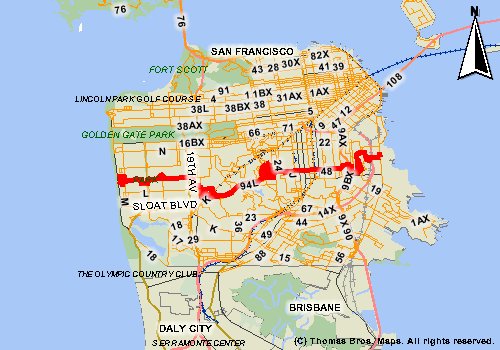« June 2005 | Main | August 2005 »
July 31, 2005
July 30, 2005
Sinosplice
Sinosplice: worthy of blogrolling: updates
Ape Rifle / China-on-the-Thames / ode to VW Santana (Dasher/Quantum/Passat ?) /
Montreal over Toronto / subtle subtitles
July 29, 2005
bad architecture in Beijing
An investigation of the not-so-subtle bad architecture in Beijing.

by 'Crazy' Jian Zhu
Update 2005 Aug 01: site hacked, look for archives.
July 28, 2005
Chinese Triad
Chinese Triad photo journal.
July 27, 2005
Correlation-dependent Credit Structural Model
In 1976 Black and Cox proposed a structural model where an obligor
defaults when the value of its assets hits a certain barrier. In 2001
Zhou showed how the model can be extended to two obligors whose assets
are correlated. In this paper we show how the model can be extended to
a large number of different obligors. The correlations between the
assets of the obligors are determined by one or more factors.
We examine the dynamics for credit spreads implied by the model and
explore how the model price tranches of collateralized debt
obligations (CDOs). We compare the model with the widely used Gaussian
copula model of survival time and test how well the model fits market
data on the prices of CDO tranches.
We consider two extensions of the model. The first reflects empirical
research showing that default correlations are positively dependent on
default rates. The second reflects empirical research showing that
recovery rates are negatively dependent on default rates.
The Valuation of Correlation-dependent Credit Derivatives Using a
Structural Model
John Hull, Mirela Predescu, and Alan White
July 26, 2005
Moodys KMV 2005 Credit Risk Research
July 25, 2005
Optimal Recursive Refinancing and the Valuation of Mortgage-Backed Securities (Longstaff)
The optimal recursive refinancing problem where a borrower minimizes
his lifetime mortgage costs by repeatedly refinancing when rates
drop. Key factors affecting the optimal decision are the cost of
refinancing and the possibility that the mortgagor may have to
refinance at a premium rate because of his credit.
The optimal recursive strategy often results in prepayment being
delayed significantly relative to traditional models. Furthermore,
mortgage values can exceed par by much more than the cost of
refinancing. Applying the recursive model to an extensive sample of
mortgage-backed security prices, we find that the implied credit
spreads that match these prices closely parallel borrowers’ actual
spreads at the origination of the mortgage. These results suggest
that optimal recursive models may provide a promising alternative
to the reduced-form prepayment models widely used in practice.
Francis A. Longstaff, Anderson School of Management.
Francis A. Longstaff, "Optimal Recursive Refinancing and the Valuation
of Mortgage-Backed Securities" (December 1, 2002). Finance. Paper 15-02.
July 24, 2005
Classic Saint Louis roof repair
Saint Louis Slate and Tile Roofering Co. will inspect and fix
your classic Saint Louis roof.

July 23, 2005
Modelling Dependence with Copulas for Risk Management
Modelling of dependence is one of the most rucial issues in risk
management. Whereas classically independence was equated to linear
correlation, more recently, mainly due to extremal market moves,
the limitations of the linear correlation concept were strongly felt.
In order to stress test dependence in a financial or insurance
portfolio, the notion of copula offers a versatile tool.
* Basic properties of copulas,
* The underlying simulation and numerical issues,
* Use of copula based techniques in integrated risk management.
[*]
July 22, 2005
Dependence Modelling in Risk Management
* Simulation of dependent risks,
* Statistical estimation of correlation in the static case,
* Dependence and correlation in a dynamically changing environment
* Extremes for heavy-tailed random vectors and multivariate stochastic processes.
Crucial to questions of risk aggregation, the project aims to
establish the fundamentals of dependence and correlation modelling.
July 21, 2005
Asset prices by Enricode Giorgi
Default models and asset pricing models at Enricode Giorgi's resource,
some with correlated defaults.
July 20, 2005
Philip Greenspun
Commercial software for the web was his first major writing topic,
but now aviation, travel, and standard of living.
software engineering jobs seem to be concentrated in parts of
the U.S. where the cost of living is very high, e.g., Silicon Valley,
Boston, and Washington, DC. Finally the methods of software
engineering haven't changed since either 1957 (if you program in an
imperative language such as C or Java) or 1970 (if you program in
SQL). This has made programmer careers more vulnerable to
offshoring than the careers of traditional engineers.
[Philip Greenspun *]
July 19, 2005
sas proc quantreg for quantile regression
Some PROC QUANTREG features are:
* Implements the simplex, interior point, and smoothing algorithms for
estimation
* Provides three methods to compute confidence intervals for the
regression quantile parameter: sparsity, rank, and resampling.
* Provides two methods to compute the covariance and correlation
matrices of the estimated parameters: an asymptotic method and a
bootstrap method
* Provides two tests for the regression parameter estimates: the Wald
test and a likelihood ratio test
* Uses robust multivariate location and scale estimates for leverage
point detection
* Multithreaded for parallel computing when multiple processors are
available
July 18, 2005
PMI Group
Economic and Real Estate Trends from the PMI Group.
July 17, 2005
SAS examples with explanation at ucla.edu/stat/SAS/
July 16, 2005
BOINC broke SETI
SETI vs Mac OS X: broken.
SETI sadly converted to the incomplete, non-working BOINC.
July 15, 2005
OAS measure of yield
OAS measure of yield has been introduced to accurately price callable
bonds but is also used now as a measure for bullets' yield.
1. For bullets, it is more accurate than yield to maturity (YTM) as
a. You use implied forward rates instead of the yield to maturity as
a reinvestment rate.
b. You discount using the zero cpn curve instead of the YTM
Even more, you calibrate your forward rates so that the PV of yor
coupons match the market values.
2. For callable bonds and MBS, the YTM measure also assumes holding
till maturity which is obviously inaccurate so the OAS uses binomial
tree which takes into account the contingency of the future coupons.
The OAS is a constant spread to the whole discount curve you use
( e.g. treasury) which would result in a PV equal to the market price.
[Wilmott (Sun Apr 27, 03 06:01 PM )]
July 14, 2005
sas proc sql joins data merging
data step merge statements corresponding to various joins.
INNER JOIN
merge data1 (in=a) data2 (in=b); by id;
if a and b;
LEFT JOIN
merge data1 (in=a) data2 (in=b); by id;
if a;
RIGHT JOIN
merge data1 (in=a) data2 (in=b); by id;
if b;
FULL JOIN
merge data1 (in=a) data2 (in=b); by id;
[ Quicktips 0206, A Visual Introduction to SQL Joins:, sql workshop at PennPop ]
July 13, 2005
HTML Ampersand Character Codes ascii
July 12, 2005
sas proc sql assign value to macro variable
Calculate a value and assign it to a macro variable with
sas proc sql
proc sql noprint;
select ssn format=9. into :ssnok
separated by ' ' from ssn_list;
quit;
%put &ssnok;
123456789 234567890 345678901 456789012
[CREATING MACRO VARIABLES VIA PROC SQL PDF]
July 11, 2005
GIS realtime: BusMonster Seattle
GIS realtime for commuting, BusMonster (motd) maps routes through Seattle.
With help by Intelligent Transportation Systems Research Program at UW.
Compare to the hideous 511.org in San Francisco

July 10, 2005
Array manipulation: Perl Data Language (PDL) and piddles
To COMPACTLY store and SPEEDILY manipulate the large
N-dimensional data sets which are the bread and butter
of scientific computing. e.g. $a=$b+$c can add two
2048x2048 images in only a fraction of a second.
Perl Data Language (PDL), PDL::Impatient - PDL for the impatient
A PDL scalar variable (an instance of a particular class of
perl object, i.e. blessed thingie) is a piddle.
Mozbot, France's prettier Google
Search for stylized facts or for Coruscation at Mozbot, France's prettier Google.
July 9, 2005
Subprime mortgage rate spread at origination
Effects largely captured by a single variable: spread at origination
(SATO). SATO measures the difference in the mortgage rate between the
specified loan and a constant-quality subprime mortgage rate. Assuming
that lenders price borrower risk efficiently, a higher SATO
implies a poorer-credit borrower.
Search for more .
July 8, 2005
Castle Coalition
Eminent domain, condemnation, expropriation:
“Nor shall private property be taken for public use without just compensation.”
U.S. Constitution, Amendment V
Castle Coalition opposes taking, even with just compensation.
Peter Sprigg thinks marriage if more for public purpose than private purpose.
(Family Research Council at panel discussion at the University of Pennsylvania,
February 12, 2004).
July 7, 2005
Econ Browser / James Hamilton
Econbrowser, time series economist looks a current economic, investment
and business news.
July 6, 2005
Police unsure how to enforce squeegee kids law
Vancouver police and the RCMP are not rushing to enforce B.C.'s new
law outlawing aggressive panhandling and squeegeeing, saying it will
take them some time to figure out exactly how they're going to use
it.
"Will there likely be any tickets issued today? Probably not,"
Vancouver police spokesman Const. Howard Chow said Friday. "And it's
not because we don't like the act -- but it's growing pains with any
new legislation coming out. It was just released yesterday."
Chow said the department still needs time to get details about the
Safe Streets Act and its penalties out to its officers on the beat
and to resolve enforcement issues, such as how to issue tickets to
people without a fixed address.
Chad Skelton and Krisendra Bisetty
Vancouver Sun
2005 January 29
Police unsure how to enforce squeegee kids law
Chad Skelton and Krisendra Bisetty
Vancouver Sun
2005 January 29
Vancouver police and the RCMP are not rushing to enforce B.C.'s new
law outlawing aggressive panhandling and squeegeeing, saying it will
take them some time to figure out exactly how they're going to use
it.
"Will there likely be any tickets issued today? Probably not,"
Vancouver police spokesman Const. Howard Chow said Friday. "And it's
not because we don't like the act -- but it's growing pains with any
new legislation coming out. It was just released yesterday."
Chow said the department still needs time to get details about the
Safe Streets Act and its penalties out to its officers on the beat
and to resolve enforcement issues, such as how to issue tickets to
people without a fixed address.
"We [need to] have a chance to inform our members on the act itself
and how to use it effectively," he said. "And, like everything else
new, once members become aware of it and become aware of its
effectiveness, undoubtedly they'll use it if the situation warrants
it."
The RCMP also said it is still in the process of reviewing the act.
"It's not a matter of delaying it. It's being cautious and making
sure the right things are in place," said provincial RCMP spokesman
Cpl. Anthony Choy.
Both forces stressed that the act is now law and -- if they receive a
complaint from the public -- they will act on it.
"If [someone] is walking down the street and encounters aggressive
panhandlers, I would recommend they walk away and call the police,"
said Chow, adding if the person feels in danger they should call 911.
Attorney-General Geoff Plant said he's not upset that police are
taking some time to figure out how to use the new law.
"It's not an issue that gives me any concern," he said. However, he
added, "I hope that their consideration is something that takes days
and weeks and not months. If we were to fast-forward four or five
months from now and find that police were still thinking about how to
use the tool, I would be disappointed."
Plant said while he is happy with the media attention the new act has
received -- which he hopes will encourage people to stop aggressive
panhandling -- he thinks it may have created unrealistic
expectations.
"To me, the entertainment is over the extent to which media outlets
are so determined to see if the world has been transformed in 90
minutes or less," he said.
Chow said the VPD are not yet clear what impact the act will have on
the already overworked department.
"Sure it's going to stretch our resources," he said. "But that's what
we're there for -- to keep the streets safe."
Choy said RCMP detachments across the province are still figuring out
how to fit enforcement of the new act into their existing budgets.
"We're more or less trying to determine how it works with our current
service delivery and enforcement plans," he said. "We are at the
stage of analyzing the legislation and seeing how it can be applied
on a day-to-day basis. I would say by next week we would have
something better to tell you."
While the details are still being worked out, Chow said the VPD
supports the law, particularly after receiving "scores" of complaints
from merchants, tourists and people who are being badgered by
beggars.
"This is just going to increase our arsenal," he said. "I think most
of us have probably experienced, having lived in an urban environment
like Vancouver, where you have panhandlers in your face, [who] won't
let you pass, aggressively asking you, sometimes threatening you, for
money."
The new act specifies that tickets ranging from $86 to $115 can be
issued to people for asking for money in a threatening manner, asking
for money while on a roadway (as squeegee kids do) or asking for
money from someone in a "captive location," such as a bank machine,
pay phone or bus stop.
In particularly serious cases, police can file a report to Crown
counsel and an offender could be sent to jail for up to six months.
However, people will not be sent to jail for not paying their fines.
The new law is similar to legislation introduced in Ontario in late
1999 that was directed primarily at squeegee kids.
That law has been heavily used -- with more than 2,000 tickets issued
in its first two years.
In Ottawa alone, police issued 764 tickets under the act in 2003,
with most tickets being issued for squeegeeing, begging in a parking
lot and aggressive panhandling.
Cities in Ontario have seen a noticeable drop in squeegeeing in
particular, but there have been some concerns raised about how those
street people are now making money.
A 2003 study by the University of Guelph that tracked 50 homeless
youth both before and after the squeegee law was introduced in
Ontario found a dramatic drop in the number of teens cleaning windows
for money.
Before the act was introduced, 65 per cent of the teens relied on
cleaning car windows as their primary source of funds.
Following the act's introduction, that dropped to just 24 per cent.
Most of the homeless youth switched to less aggressive forms of
panhandling to replace the lost income, but the survey also found an
increase in the number of male teens selling drugs.
The study also found a large increase in the number of teens relying
on some form of income assistance.
cskelton@png.canwest.com
© The Vancouver Sun 2005
July 5, 2005
Don't Need Your Gheto Scenes
July 4, 2005
lancemannion
Orson Scott Card: Science Fiction writer or
wholly derivative polemicist ? At Lance Mannion.
July 3, 2005
Economics Roundtable
Economics Roundtable aggregates interest rates, markets and other
economics topics.
July 2, 2005
V&V: Verification, Validation
Verification: testing against specifications.
Validation: testing against operating goals.
If You Didn't Test It, It Doesn't Work.
Computer, 2002 May, p12
Bob Colwell
July 1, 2005
Art of the New Urbanist Deal
New urbanism proposes new models for the urban design of
master-planned communi-ties and town centers. The financial
performance of three projects is examined in detail: Seaside, a
second-home resort in Florida; Lakelands, a master-planned community
in Gaithersburg, Maryland; and Haile Village Center, a mixed-use
residential, commercial, and retail center outside Gainesville,
Florida.
Seaside, which consists of 630 residential units, about 45,000 square
feet of retail, and about 18,000 square feet of commercial space, has
slowly developed into a financial success. The first lots sold in 1982
for $15,000; by 1992, the average price of new lots sold was $130,000
and by 2001 it was $690,000. The project has become a model for
several larger second-home village-type resorts in northwest Florida.
Lakelands, with 220 developable acres, has about 1,572 residential
units (houses as well as multi-family), the majority produced by
national homebuilders. The selling rate has been good: in the first
three years, the project sold about 400 units a year.
The land at Haile Village was originally bought for $2,500 per acre
and is today sell-ing for more than $300,000 per acre; the value of
the project at build-out is estimated to be about $500,000 per acre.
Due to lack of visibility, there has been some difficulty in
attracting a large variety of retail tenants.
Witold Rybczynski, "undated".
"The Art of the New Urbanist Deal"
Zell/Lurie Center Working Papers 429,
Wharton School Samuel Zell and Robert Lurie Real Estate Center,
University of Pennsylvania.
Wharton Real Eastate Review, Fall 2002.

